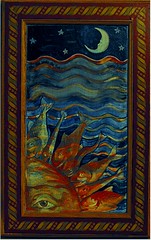This is a painting by the late Donna G Moore in which more is happening than meets the eye.
The wavingly cheery rays of the sun as he burns, somehow, under the sea are not what they seem in this painting.
For the rays are not radiant lines but fish. And those fish are eating the rim of the sun.
What?
The pre-Christian history of the fish symbol includes:
The fish symbol has been used for millennia worldwide as a religious symbol associated with the Pagan Great Mother Goddess. It is the outline of her vulva. The fish symbol was often drawn by overlapping two very thin crescent moons. One represented the crescent shortly before the new moon; the other shortly after, when the moon is just visible. The Moon is the heavenly body that has long been associated with the Goddess, just as the sun is a symbol of the God.
The link between the Goddess and fish was found in various areas of the ancient world, says religioustolerance.org:
- In China, Great Mother Kwan-yin is often portrayed in the shape of a fish.
- In India, the Goddess Kali was called the "fish-eyed one."
- In Egypt, Isis was called the Great Fish of the Abyss.
- In Greece the Greek word "delphos" meant both fish and womb. The word is derived from the location of the ancient Oracle at Delphi who worshipped the original fish goddess, Themis. The later fish Goddess, Aphrodite Salacia, was worshipped by her followers on her sacred day, Friday. They ate fish and engaged in orgies. From her name comes the English word "salacious" which means lustful or obscene. Also from her name comes the name of our fourth month, April. In later centuries, the Christian church adsorbed this tradition by requiring the faithful to eat fish on Friday - a tradition that was only recently abandoned.
- In ancient Rome Friday is called "dies veneris" or Day of Venus, the Pagan Goddess of Love.
- Throughout the Mediterranean, mystery religions used fish, wine and bread for their sacramental meal.
- In Scandinavia, the Great Goddess was named Freya; fish were eaten in her honor. The 6th day of the week was named "Friday" after her.
- In the Middle East, the Great Goddess of Ephesus was portrayed as a woman with a fish amulet over her genitals.
Thus the Moore painting is using classic feminist symbols to turn the world on its head. She wants to say, symbolically, that there might be a day when the moon and the fish take down the sun.
Subscribe to:
Post Comments (Atom)





No comments:
Post a Comment